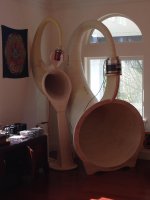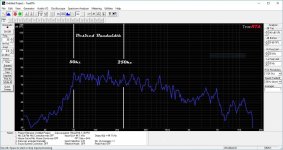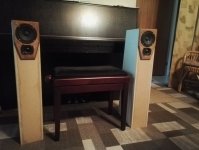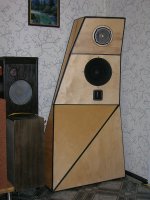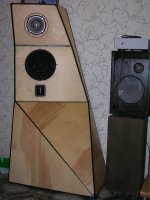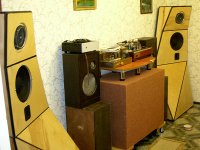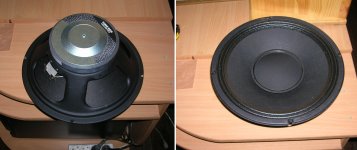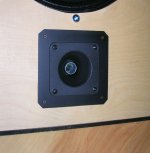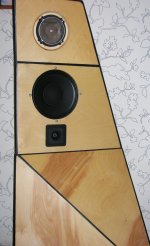Here a three way horn system I'm fabricating. The larger horn is a bass/mid bass unit (50hz to 250hz), the smaller horn in the upper left is the midrange unit (250hz to 6000hz) and the tweeter horn is a sweet sounding Fostex.
The midrange horn is paper mache. The bass/midbass horn is solid maple. The drivers are Ale.
The midrange horn is paper mache. The bass/midbass horn is solid maple. The drivers are Ale.
Attachments
Amazing work. But the horn mouths, shouldn't they be bigger? I use a hoen from 440-2000Hz and the mouth is about 80x50cm. Any measurements?
Here's an RTA of the bass horn. I don't have one of the midrange, yet.
Attachments
Celestion K12H-200TC (on a full range) + Fountek NeoCD3.5H (above 10 kHz)
Bass reflex, сabinets 190L.
Bass reflex, сabinets 190L.
Attachments
Here a three way horn system I'm fabricating. The larger horn is a bass/mid bass unit (50hz to 250hz), the smaller horn in the upper left is the midrange unit (250hz to 6000hz) and the tweeter horn is a sweet sounding Fostex.
The midrange horn is paper mache. The bass/midbass horn is solid maple. The drivers are Ale.
Amazing construction!
How did you fabricate that?
Do you have some pictures of the process?
2 ways / full horn.....
Nice work. The floor concrete bass horns with Altec 515 sound great. How low do they go?
Looks like a lot of work. Well done.Celestion K12H-200TC (on a full range) + Fountek NeoCD3.5H (above 10 kHz)
Bass reflex, сabinets 190L.
Nice work. The floor concrete bass horns with Altec 515 sound great. How low do they go?
30 Hz -3dB, 50 hz 0dB
At the moment, the system uses one TacT RCS and two TacT 2150s. The filters are located in the DSP of the amplifiers.
As they malfunction a little, today I'm going to try a Benchmarkk DC1, a crossover Rane Ac23, a Crown XLS 1502 for the bass and a Hiraga 8w for the medium-acute.
30 Hz -3dB
Toole has shown tha F3 is meaningless to the human ear/brain, what are the F6/F10?
dave
Toole has shown tha F3 is meaningless to the human ear/brain, what are the F6/F10?
dave
Dave- you seem to mention this a lot. Why is F6 or F10 so much better? I don't see how they tell you anymore than F3.
A: F3 is an artifact of the T/S theory being an electricl filter analogy (useful if you are using the box roll-off as part of the filter to cross something lower). Toole has shown it is a meaningless number. F6 is more meaningful to the human ear/brain and if you have F10 you have a better idea of the shape of the rolloff. Better yet would be curves, their shape can be telling.
F3 is currently embedded in the culture i am trying to move that.
dave
F3 is currently embedded in the culture i am trying to move that.
dave
A: F3 is an artifact of the T/S theory being an electricl filter analogy (useful if you are using the box roll-off as part of the filter to cross something lower). Toole has shown it is a meaningless number. F6 is more meaningful to the human ear/brain and if you have F10 you have a better idea of the shape of the rolloff. Better yet would be curves, their shape can be telling.
F3 is currently embedded in the culture i am trying to move that.
dave
Curves of course would be more helpful but I still don't see how F6 is more useful than f3. They are still giving a basic indication of the bass extension. Any two points along the curve would be better than one.
Last edited:
It's a reference point, your brain doesn't have to perceive the difference. The point of reference is not that important, it's the familiarity thats important. I think yours is a semantic argument.The ear/brain can perceive -6dB, it can’t -3dB.
dave
A: F3 is an artifact of the T/S theory being an electricl filter analogy (useful if you are using the box roll-off as part of the filter to cross something lower). Toole has shown it is a meaningless number. F6 is more meaningful to the human ear/brain and if you have F10 you have a better idea of the shape of the rolloff. Better yet would be curves, their shape can be telling.
F3 is currently embedded in the culture i am trying to move that.
dave
I see the F3 as where the slope starts, but the F10 tells untill where the usable bass goes. So for the description of the bassresponse the F10 (aka FS) is way more usefull than the F3. But it does not mean that the F3 is useless from designers perspective.
But it does not mean that the F3 is useless from designers perspective.
Only from the ear/brain perspective.
dave
- Home
- Loudspeakers
- Multi-Way
- System Pictures & Description
